#Kyrgyzstan President Sadyr Japarov
Text
President Ersin Tatar meets Kyrgyzstan President Sadyr Japarov
“We discussed developing bilateral relations between our two countries”
President Ersin Tatar has met with the President of Kyrgyzstan Sadyr Japarov at the Presidency in Bishkek on Monday 4th December 2023.
The private meeting between President Tatar and President Japarov continued with the participation of the delegations from the two sides. Evaluating the meeting, President Tatar said that…

View On WordPress
#Direct Flights#Discussed Cyprus issue#Kyrgyzstan President Sadyr Japarov#Organisation of Turkic States#President Ersin Tatar#Turkic world
0 notes
Text
[AkiPress is Kyrgyz Media]
[RFERL is US State Media]
17 Jul 23
19 notes
·
View notes
Text
Last month, soldiers from Kyrgyzstan and Tajikistan exchanged gunfire along several points of the countries’ undemarcated border. After a brief cease-fire, fierce fighting resumed and escalated from border areas into the territory of Kyrgyzstan, hitting remote areas of Osh province. Tajikistan’s military destroyed a bridge crossing the Ak-Suu River, residential areas, and businesses. The Tajik military then occupied and erected a flag on a public school in Dostuk village in Batken province. Kyrgyzstan shelled Tajikistan’s border areas well.
The conflict was among the most serious interstate military escalations in Central Asia’s history since the dissolution of the Soviet Union in 1991. On the Kyrgyz side, at least 62 civilians and military officers died, 198 were wounded, and roughly 136,000 were internally displaced. The Tajik authorities officially confirmed 41 dead among civilians and military personnel. The Kyrgyz Ministry of Foreign Affairs has condemned Tajikistan for committing an act of war and claimed that the aggression was premeditated and prepared. The Tajik Ministry of Foreign Affairs blamed Kyrgyzstan for aggression and violation of norms of international humanitarian law.
The conflict also reveals the limitations of both China- and Russia-led regional security organizations in Central Asia. Both states clashed when China, Russia, and Central Asian countries were gathering at the Shanghai Cooperation Organisation (SCO) summit in Samarkand, Uzbekistan—just 200 miles away from the Kyrgyz-Tajik border. Both Tajik President Emomali Rahmon and his Kyrgyz counterpart, Sadyr Japarov, were present at the summit and met with Chinese President Xi Jinping and Russian President Vladimir Putin while the skirmishes occurred. The conflict was discussed by the Tajik and Kyrgyz presidents at a side event but not at the main venue.
The SCO’s reluctance to resolve conflicts among its members reveals how it is limited to promoting only China’s security interests in the region. Beijing is interested primarily in strong regimes in Central Asia that will suppress the Uyghur minority and support China’s Belt and Road Initiative in the region. It has made clear that its Central Asian members must find other venues for solving intraregional territorial disputes.
Likewise, both Kyrgyzstan and Tajikistan are members of the Russian-led Collective Security Treaty Organization (CSTO), which historically chose not to intervene in interstate conflicts among its members. The only time it acted in unity and deployed troops to a member state’s territory was to suppress demonstrations in Kazakhstan this January. When Kyrgyz and Tajik militaries clashed in April 2021, the CSTO was holding a summit in the Tajik capital, Dushanbe. The organization made no note of it.
In response to the recent clashes, the CSTO offered diplomatic mediation between Bishkek and Dushanbe. But the statement likely represented the Kremlin’s, and not the CSTO’s, approach to the conflict and its interest in stopping further destabilization. Russia is not interested in a Central Asia united without its patronage, but it also doesn’t want to see the region turn into a source of instability along its southern borders.
Unlike the renewed fighting between Armenia and Azerbaijan, which has been widely attributed to Russia’s weakening, the aggression in Central Asia is driven mostly by domestic factors. If the Russian president still plays a role in the conflict, it is from a position of strength, not weakness. The sense in Kyrgyzstan is that the CSTO could not avert Rahmon’s aggression because he enjoys close relations with the Kremlin. Throughout Russia’s invasion of Ukraine, Rahmon has remained loyal to Putin. He hosted him in June in Dushanbe.
As a sign of Moscow’s support for the impending dynastic transition, Russian Federation Council Speaker Valentina Matvienko met with Rahmon’s 34-year old son, Rustam Emomali, in Dushanbe the day Russia invaded Ukraine. Some in Kyrgyzstan fear that their country’s neutral position on Russia’s invasion of Ukraine is the root of Putin’s stronger support of Tajikistan.
The escalation along the Kyrgyz-Tajik border is not new. Small clashes flare up along the border on a regular basis, with the deadliest fight to date unraveling in April 2021, when dozens of civilians were killed and hundreds wounded. Many factors are at play. The Soviet delimitation of national borders in the Ferghana Valley produced a complex geography. Of the roughly 600-mile border between Tajikistan and Kyrgyzstan, only half is demarcated. Two Tajik exclaves, Vorukh and Kayragach (also known as Lolazor), are in Kyrgyzstan, contributing to tensions between the two states.
But the real problem has roots in modern politics: In both Kyrgyzstan and Tajikistan, leaders use border tensions for their domestic political benefit. Even though both are drastically different regimes—Tajikistan’s is deeply autocratic and Kyrgyzstan’s populist—both have adopted populist approaches to the border area instead of trying to negotiate a peaceful coexistence for the local population. Japarov promised to resolve border issues to consolidate support ahead of the presidential election in 2021, while Rahmon employs expansionist rhetoric to consolidate the nation around his regime.
On the Tajik side, the regime has been acquiring ammunition and receiving military training from Russia, China, and Iran. China’s Ministry of Public Security financed the launch of a new military base in Tajikistan to counter threats emanating from Afghanistan, and Iran opened a production facility to produce Ababil-2 tactical drones. Sharing a long border with Afghanistan, Tajikistan has also been receiving extensive security aid from the United States and the European Union. The U.S. government supports Tajikistan with tactical weapons and military-to-military trainings. Kyrgyzstan also receives security assistance from the United States, but most programs focus on democracy-building.
Rahmon has ruled Tajikistan for nearly three decades, since the civil war in the 1990s. He imprisoned, forced out of the country, or killed all members of the opposition. Rahmon is also reportedly planning to transfer power to his son. Escalating a conflict with Kyrgyzstan under the pretense of protecting borders and ethnic Tajiks helps consolidate control over the military and state officials for the impending dynastic succession.
In Kyrgyzstan, the leadership is newly established and less autocratic. Japarov and his close ally Kamchybek Tashiev, the head of the State Committee for National Security, were able to win controversial elections in early 2021 on a populist platform. Territorial sovereignty and border security featured high on their agenda. They purchased Turkish Bayraktar drones and Russian armored personnel carriers to prop up their otherwise dilapidated armed forces.
Perhaps emboldened by their earlier successful delimitation of borders with Uzbekistan after a long history of frequent armed border disputes, they then held a ceremony to demonstrate the newly acquired military equipment in Bishkek. Tajikistan and less so Kyrgyzstan fortified their borders with military and civilian personnel, especially around densely populated disputed areas.
Japarov’s relations with Moscow are less secure than Rahmon’s primarily because he came to power as a result of mass protests and by replacing his predecessor. Japarov has also struggled to bring trade with China back to its pre-pandemic level, even after China eased domestic lockdowns.
By escalating fighting with Kyrgyzstan, Rahmon has been able to divert domestic attention from his recent violent clampdown on political activism among Pamiris, a minority population in Tajikistan’s Gorno-Badakhshan autonomous region that identifies with the Ismaili branch of Shiite Islam. Gorno-Badakhshan—with its distinct local identity—remains the last place of civic resistance to Rahmon’s authoritarianism. Dozens of people have died in clashes with the government since late 2021. Rahmon recently shut down two important Ismaili institutions—a school and a bookshop.
Japarov’s populist policies, corruption, and repression of opponents have been severely criticized and challenged at home. The government’s unpreparedness in the face of Tajik aggression last month became fully exposed to the domestic audience. Where Japarov’s government is lacking, Kyrgyzstan’s robust civil society and independent media fill the gaps. Grassroots campaigns to support internally displaced people and provide open information sprang up across the country. People offered shelter, food, and clothing to the victims of the conflict.
But the effect of a weak civil society in Tajikistan and strong grassroots mobilization in Kyrgyzstan will likely have an inverse effect. Rahmon will be able to consolidate the security apparatus for a successful transfer of power to his son. He relies on the nationalist sentiment of protecting ethnic Tajiks along the unstable border with Kyrgyzstan.
By contrast, in Kyrgyzstan, Japarov and Tashiev come across as incapable of stopping the external aggressor and allowing high numbers of casualties. Kyrgyzstan in some ways resembles Armenia, where Prime Minister Nikol Pashinyan has been unable to hold territory while his authoritarian neighbor makes gains and consolidates power. In both Armenia and Kyrgyzstan, protesters are calling for their governments to withdraw from the CSTO. With every security or social crisis in Kyrgyzstan, civil society networks mobilize and can fuel protest potential against the unpopular government. The latest clashes with Tajikistan may further destabilize Kyrgyz politics.
Neither China nor Russia wants growing instability in Central Asia, even if it involves smaller countries like Kyrgyzstan and Tajikistan. Both Kyrgyzstan and Tajikistan are heavily indebted to China. Both also have hundreds of thousands of migrant laborers working in Russia. Yet, even with strong economic influence, neither country can deliver on security guarantees for conflicts in Central Asia. Instead, the clashes exposed both the SCO’s and the CSTO’s inadequacy in preventing the escalation of tensions among their member states.
Future conflict prevention and resolution in Central Asia will depend on whether Western partners, including the Organization for Security and Cooperation in Europe, the U.S. government, and the EU, are willing to mediate regional tensions. Like the high-level visit by U.S. House Speaker Nancy Pelosi to Armenia to demonstrate U.S. support for interstate peace in the South Caucasus, now is the time for Western partners to support regional peace and prevent future loss of lives. Both Russia and China will likely oppose any expanded Western presence in the region, but they will continue to fall short when it comes to offering alternatives that bring about a more peaceful Central Asia.
3 notes
·
View notes
Text
Putin held first EAEU summit after inauguration
A summit of the Eurasian Economic Union (EAEU) was held in Moscow under the chairmanship of Armenia, Russian media reported.
The EAEU summit started in the Kremlin on May 8 and was attended by President of Belarus Alexander Lukashenko, President of Kazakhstan Kassym-Jomart Tokayev, President of Kyrgyzstan Sadyr Japarov and Prime Minister of Armenia Nikol Pashinyan.
They were also joined by the leaders of the EAEU observer countries: President of Uzbekistan Shavkat Mirziyoyev and Cuban President Miguel Díaz-Canel.
Under the Armenian chairmanship, the leaders of the EAEU member states adopted a number of documents, including the one marking the start of negotiations on a trade agreement with Mongolia. The participants also adopted a draft protocol on the electronic exchange of information between the EAEU and Vietnam. The protocol addresses the electronic verification system and verification of goods’ origin.
Putin urged EAEU member states to make joint efforts to achieve further integration and comprehensive development within the bloc.
The volume of mutual trade has almost doubled from 45 billion to 89 billion US dollars.
Lukashenko stated that Russia’s efforts to strengthen the partnership of member states were “more important than ever,” and the measures taken contributed to the extension of mutual trade, with a growth rate of “about $90 billion.” Tokayev, for his part, emphasised that the EAEU must become “more flexible and efficient” amid impending economic challenges.
Read more HERE

#world news#world politics#news#russia#russia news#russian news#russia politics#russian politics#EAEU#vladimir putin#putin#russian president#kyrgyzstan#uzbekistan#belarus#armenia#kazakhstan#cuba#inauguration#inauguración
0 notes
Text
Putin visits Kyrgyzstan in first trip abroad since ICC arrest warrant
Russian President Vladimir Putin arrived in Bishkek, Kyrgyzstan, on Oct. 12 and met with Kyrgyz President Sadyr Japarov ahead of the Commonwealth of Independent States (CIS) summit. Ostensibly one of Source : kyivindependent.com/putin-vis…
0 notes
Text
KYRGYZSTAN: President Putin arrives in Bishkek in first known trip abroad since ICC arrest warrant
Russian President Vladimir Putin arrived in the capital of Kyrgyzstan Bishkek on Thursday, October 12, to attend the annual Commonwealth of Independent States heads summit. Kyrgyz President Sadyr Japarov welcomed Putin at the Ala Archa State Residence.
Putin also laid a wreath at the Ata Beyit Memorial Complex outside Bishkek, honouring Kyrgyzstan’s victims of Soviet-era repression.
This is…

View On WordPress
0 notes
Text

Vladimir Putin, Prime Minister of Armenia Nikol Pashinyan, President of Belarus Alexander Lukashenko, President of Kazakhstan Kassym-Jomart Tokayev, President of Kyrgyzstan Sadyr Japarov, President of Tajikistan Emomali Rahmon and President of Uzbekistan Shavkat Mirziyoyev toured part of the permanent exhibition on display at the Mikhailovsky Palace.
The leaders visited the halls exhibiting art of the early 19th century by Karl Bryullov, Ivan Aivazovsky and Fyodor Bruni, among other works. Director of the Russian Museum Vladimir Gusev conducted the tour.
Founded in 1898, the Russian Museum is the world’s largest museum of Russian art. Its collection of more than 400,000 masterpieces spans more than 1,000 years, from the 10th to the 21st century. The museum’s architectural complex in historical St Petersburg consists of the Mikhailovsky Garden, the Summer Garden with Peter the Great’s Summer Palace, Peter the Great’s House and the Mikhailovsky Palace.






(Source)
#vladimir putin#russia#aleksandr lukashenko#belarus#nikol pashinyan#armenia#kassym-jomart tokayev#kazakhstan#sadyr japarov#kyrgyzstan#emomali rahmon#tajikistan#shavkat mirziyoyev#uzbekistan
1 note
·
View note
Text
Precedence instructions of investments of Azerbaijani-Kyrgyz Improvement Fund named (Unique)
BAKU, Azerbaijan, October 15. The Joint
Azerbaijani-Kyrgyz Improvement Fund with a funds of $25 million
will likely be implementing investments in precedence tasks for the
founders in Kyrgyzstan by offering loans and credit, the Ministry
of Financial system and Commerce of Kyrgyzstan instructed Pattern.
The ministry famous that the founders will take part in capital
and use of different instruments in relation to enterprise entities registered
and working on the territory of Kyrgyzstan.
“Particularly, they’ll take part within the following sectors:
water provide sector; healthcare sector; automotive business;
science, analysis and expertise; gasoline industrial advanced; chemical
and petrochemical business; clothes and textile business;
manufacturing business; mining and metallurgical business;
transport; housing building; commerce; entrepreneurship
growth; power advanced; infrastructure growth;
data expertise; growth of tourism,” the ministry
acknowledged.
A signing ceremony of Azerbaijani-Kyrgyz paperwork happened
after the assembly of the First Interstate Council of Azerbaijan and
Kyrgyzstan in an expanded format with the participation of
President of Azerbaijan Ilham Aliyev and President of Kyrgyzstan
Sadyr Japarov.
Particularly, an settlement was reached on the institution of
the Joint Azerbaijani-Kyrgyz Improvement Fund. ‘Settlement on the
institution of the Joint Azerbaijani-Kyrgyz Improvement Fund’ was
signed by Deputy Prime Minister of Azerbaijan Ali Ahmadov and
Chairman of the Cupboard of Minister of Kyrgyzstan Bakit
Torobayev.
Originally published at Irvine News HQ
0 notes
Text
Sadyr Japarov took office as President of Kyrgyzstan
Sadyr Japarov authoritatively got to work as President of Kyrgyzstan, the initiation function is occurring in Bishkek on Thursday, January 28.
Sadyr Japarov authoritatively got to work as President of Kyrgyzstan, the initiation function is occurring in Bishkek on Thursday, January 28.
The service was communicated on state TV channels and on a huge screen on the focal square of the Kyrgyz capital Ala-Too.
“In getting down to business as President of Kyrgyzstan, I vow to serve the individuals of the country,” Japarov said the…

View On WordPress
0 notes
Photo

Kyrgyzstan’s acting president may seek constitution change to run for full term The Central Asian nation's constitution bars caretaker Presidents from running in the elections they oversee. Japarov took over as acting President last week after unrest toppled his predecessor Sooronbai Jeenbekov's government.
#Asia#Kyrgyzstan&039;s acting president#may seek constitution change to run for full term - CNN#Sadyr Japarov
0 notes
Text
Kyrgyzstan said Thursday it had signed several agreements with Uzbekistan settling some of the disputes on the border between the two Central Asian countries, including on the shared control of a key dam. [...]
Some of the 1,400-kilometre (870-mile) border between the two countries was not demarcated, leading to sporadic clashes between local communities over pasture or water resources.
But a source in the Kyrgyz foreign ministry told AFP that the border with Uzbekistan was now "fully" demarcated.
The countries also signed agreements "on cooperation on water management issues" and "on the joint management of water resources of the Kempir-Abad reservoir," according to the statement.
The reservoir, built when both countries were part of the Soviet Union, is a key piece of infrastructure in a region where water is increasingly scarce.
The reservoir is between the Kyrgyz region of Jalal-Abad and Och, and the Uzbek Andijan region.
It comes after Kyrgyz authorities detained more than 20 politicians and civil servants who protested the border deal last week.
The content of the deal is still unclear[...]
Kyrgyz President Sadyr Japarov denounced the opposition as "sabotage" and "provocations".
"We are recovering the dam," Japarov was quoted as saying by the state-run Kabar news agency in October.
The head of the National Security Committee Kamtchybek Tachiev said Uzbekistan would gain control of the dam.
3 Nov 22
5 notes
·
View notes
Text
Since the start of Russia’s full-scale invasion of Ukraine, a growing number of countries have severed diplomatic ties with Moscow and actively condemned its actions. There are, however, a few states that have done the opposite, and moved to strengthen relations with Moscow. Temur Umarov, a researcher at the Carnegie Endowment for International Peace, explains the case of Kyrgyzstan in an interview with Meduza.
Bishkek sympathizes with Russia’s interests
Russia has long prioritized relations with the West and China in its foreign policy agenda. Meanwhile, when the Kremlin pays attention to Central Asia, it focuses on Kazakhstan and Uzbekistan, rather than Kyrgyzstan. This is partly due to the fact that politics in Kyrgyzstan has been unpredictable, says Temur Umarov. Putin is wary of “outsiders” trying to “shake up the system,” such as current Kyrgyzstani President Sadyr Japarov, who came to power amid violent protests — even if they have authoritarian ambitions. Instead, Putin prefers to mingle with longtime autocrats like President of Tajikistan Emomali Rahmon.
Out of all the Central Asian states, Kyrgyzstan has maintained the most pro-Russian stance since the start of Russia’s war against Ukraine. When Russia first invaded, Putin received calls from leaders across Central Asia, notes Umarov, including from the Kyrgyzstani president, who emphasized his “sympathy for Russia’s interest in the stability of security issues.” (This was only mentioned on the Kremlin’s website, not on that of the Kyrgyzstani president.) However, Japarov has also publicly expressed his support for Russia, writing on Facebook that Russia’s decision to recognize the self-proclaimed Luhansk and Donetsk people’s republics was necessary in order to “protect the civilian population.” In one interview with the news channel Russia-24 after the start of the war (conducted in Russian), Japarov said Russia could always rely on Kyrgyzstan, no matter what.
Kyrgyzstan has also been open to welcoming Russians fleeing abroad, giving them simplified paths to citizenship and allowing them to work as “digital nomads.” When asked how the Kremlin feels about this, Umarov explained that it’s not an issue, since Russia has yet to close its borders or prevent people from leaving. Overall, it’s better for Russia politically if those that don’t support the government leave the country, notes Umarov. Besides, Moscow’s happy that Bishkek ensures Russians living there don’t openly oppose the war. For example, law enforcement agencies have recently banned public demonstrations against the war, threatened to deport a Russian citizen for holding an anti-war sign at a protest, and shut down an organization called Red Roof, which provides Russian with a space to discuss topics such as the war. That’s all to say that Russians are welcome in Kyrgyzstan — “as long as they’re not outspoken about their political views,” say Umarov.
Japarov eagerly accepts Putin’s invitation to the 2023 Victory Parade
The Kyrgyzstani leader was one of the only heads of state to accept the Kremlin’s invitation to attend this year’s Victory Day celebration in Red Square. Umarov says that he believes everyone except Japarov declined the invitation. The event presented Japarov with an opportunity to strengthen ties with Putin. This was especially important in the context of Kyrgyzstan’s conflict with Tajikistan, as the latter’s president was the only guest at the parade in 2021.
So why is Kyrgyzstan suddenly so intent on warming up to Russia?
Now that Russia’s under a much more strict sanctions regime and finds itself increasingly isolated, remarks Umarov, Kyrgyzstan can serve as a “window into the sanctioned world” for Russian businesses. Since Japarov wants to turn Kyrgyzstan, long considered the most democratic country in the region, into an autocracy, he sees his interests as aligned with those of Putin, and Russia’s newfound isolation to be the perfect moment to improve ties. Japarov has, on more than one occasion, expressed his desire for the country’s experiment with democracy to end, and said that he can be the “strong arm” that Kyrgyzstan needs. To work toward this goal, Japarov has re-written the constitution, got himself elected, and has attained much more power than his predecessors.
What about Kyrgyzstan’s relationship with Ukraine?
“Relations between Kyrgyzstan and Ukraine are, let’s say, suspended,” says Umarov. “I don’t think there’s much time to think about issues other than the war anyway.” Ukraine watches developments in Bishkek fairly closely, however, and immediately called Japarov’s trip to Moscow for the Victory Parade “amoral.”
Kyrgyzstan’s economic relations with Ukraine have also been put on an indefinite hold. It is important to note, though, that there is a significant difference in attitudes between the government and the general population of Kyrgyzstan. While Japarov hasn’t called Ukrainian president Volodymyr Zelensky since the start of war and has generally ignored the war, Umarov notes that Kyrgyzstani activists have regularly collected humanitarian aid for Ukraine.
What it all means for Kyrgyzstan’s future
As Japarov works to consolidate power and turn Kyrgyzstan into a full-fledged autocracy, Umarov says the Kyrgyzstani leader sees Russia as an apt “role model of authoritarian stability.” Russia’s legislation on NGOs and the media have been particularly appealing for Japarov. In fact, journalists believe that 90% of the wording for a law to control NGOs was taken directly from Russian legislation.
Kyrgyzstan has also followed Russia’s lead in cracking down on LGBT rights. Bishkek has adopted similar slogans and ideology based on the concept of “traditional values,” making life much harder for those part of the LGBT community or for those who engage in LGBT activism. Other policies that mirror those in Russia, notes Umarov, include planting drugs, closed court cases, inventing non-existent laws, and depriving people of citizenship. Like other authoritarian states, Kyrgyzstan watches Russia closely, explains Umarov, in order to adopt its best practices for preserving autocratic rule.
1 note
·
View note
Text
EU Commission-Kyrgyzstan economic ties getting stronger
European Commission Vice President Margaritis Schinas said that co-operation between the EU body and Kyrgyzstan in terms of economy and finance can be enhanced.
Schinas made the announcement after meeting with Kyrgyzstan’s President Sadyr Japarov in Bishkek, confidently highlighting advantages of the partnership. The senior officials discussed priority projects for Kyrgyzstan, investments, financing, banking prospects, as well as regional security issues.
The VP emphasised the positive trend in Central Asia, stating that the European Commission is ready to deepen its co-operation with Kyrgyzstan.
Schinas’ visit focused on climate projects, digitalisation and the development of transport corridors.
Read more HERE

#world news#world politics#news#europe#european news#european union#eu politics#eu news#european commission#kyrgyzstan
0 notes
Text
Discovering the world
Kyrgyzstan 🇰🇬
Basic facts
Official name: Кыргыз Республикасы (Kyrgyz Respublikasy)/Кыргызская Республика (Kyrgyzskaya Respublika) (Kyrgyz/Russian) (Kyrgyz Republic)
Capital city: Bishkek
Population: 6.7 million (2023)
Demonym: Kyrgyzstani
Type of government: unitary presidential republic
Head of state and government: Sadyr Japarov (President)
Gross domestic product (purchasing power parity): $48.05 billion (2024)
Gini coefficient of wealth inequality: 29% (low) (2020)
Human Development Index: 0.701 (high) (2022)
Currency: som (KGS)
Fun fact: It is home to the world’s largest walnut forest.
Etymology
The country’s name consists of the Turkic word for “we are forty”, which is believed to refer to the forty clans of legendary hero Manas, and the Persian suffix -stan, which means “place of”.
Geography
Kyrgyzstan is located in Central Asia and borders Kazakhstan to the north, China to the east and southeast, Tajikistan to the south, and Uzbekistan to the west.
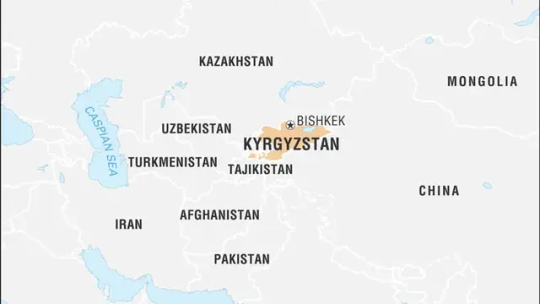
There are six main climates: warm-summer humid continental in the northeast, Mediterranean-influenced warm-summer humid continental in the west, subarctic and tundra in the center, east, and southwest, cold desert in the northwest and southwest, and cold steppe in the rest. Temperatures range from −10 °C (14 °F) in winter to 32 °C (89.6 °F) in summer. The average annual temperature is 9.6 °C (49.2 °F).
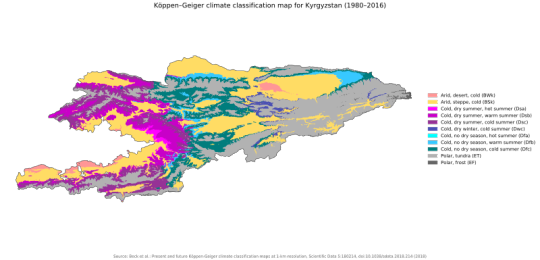
The country is divided into seven regions (oblystar/oblasti), which are further divided into 44 districts (aymaqtar/rayony). The largest cities in Kyrgyzstan are Bishkek, Osh, Jalalabad, Karakol, and Tokmok.
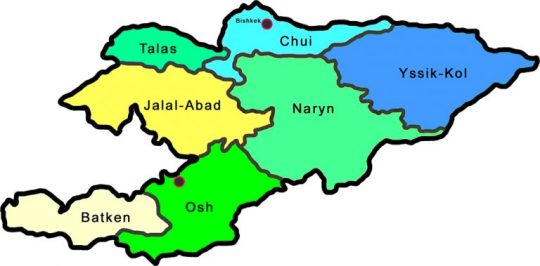
History
30-375: Kushan Empire
440s-560: Hephthalite Empire
539-1207: Kyrgyz Khaganate
552-603: First Turkic Khaganate
603-742: Western Turkic Khaganate
682-744: Second Turkic Khaganate
744-840: Uyghur Khaganate
843-1347: Qocho Kingdom
1223-1266: Mongol Empire
1266-1347: Chagatai Khanate
1501-1785: Khanate of Bukhara
1709-1876: Khanate of Kokand
1876-1917: Russian Empire
1917-1918: Turkestan Autonomy
1918-1924: Turkestan Autonomous Soviet Socialist Republic
1924-1926: Kara-Kirghiz Autonomous Oblast
1926-1936: Kirghiz Autonomous Soviet Socialist Republic
1936-1990: Kirghiz Soviet Socialist Republic
1990-1991: Republic of Kyrgyzstan
1991-present: Kyrgyz Republic
2005: Tulip Revolution
2010: Second Kyrgyz Revolution
2020: Third Kyrgyz Revolution
Economy
Kyrgyzstan mainly imports from China, Russia, and Uzbekistan and exports to the United States, Kazakhstan, and Russia. Its top exports are dry pulses, sheep and goats, and cotton.
It has antimony, coal, gold, and uranium reserves. Services represent 54.2% of the GDP, followed by industry (31.2%) and agriculture (14.6%).
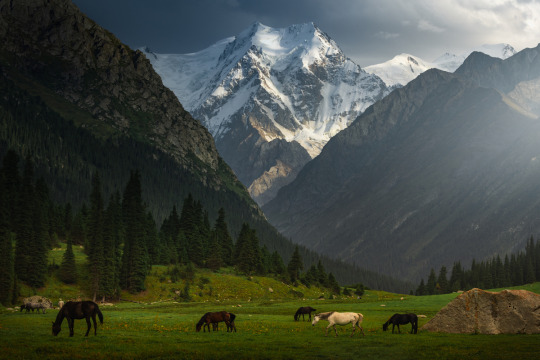
Kyrgyzstan is a member of the Collective Security Treaty Organization, the Commonwealth of Independent States, the Eurasian Economic Union, the Organization for Security and Cooperation in Europe, the Organization of Islamic Cooperation, the Organization of Turkic States, and the Shanghai Cooperation Organization.
Demographics
77.8% of the population is Kyrgyz, while Uzbeks represent 14.2% and Russians 3.8%. The main religion is Islam, practiced by 91% of the population, the majority of which is Sunni.
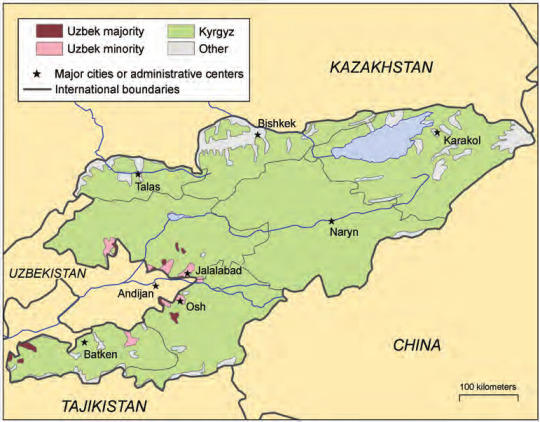
It has a positive net migration rate and a fertility rate of 3 children per woman. 38% of the population lives in urban areas. Life expectancy is 71.9 years and the median age is 24 years. The literacy rate is 99.2%.
Languages
The official languages of the country are Kyrgyz and Russian, spoken by 61.1% and 37.3% of the population, respectively.
Culture
Kyrgyzstan is known for its carpets and tapestries and nomadic farming. Bride kidnapping, although illegal, is still practiced.
Men traditionally wear a shirt (keynek), wide, embroidered pants (chalbar), a wide belt (kemer), a felt robe (kementay), and a white felt hat (kalpak). Women wear a white shirt (keynek) and long pants or a dress, an embroidered vest (chyptama), and a white muslin turban (elechek) or a conical hat with a veil (topu).

Architecture
Traditional houses in Kyrgyzstan are conical wooden structures covered in felt and wool.
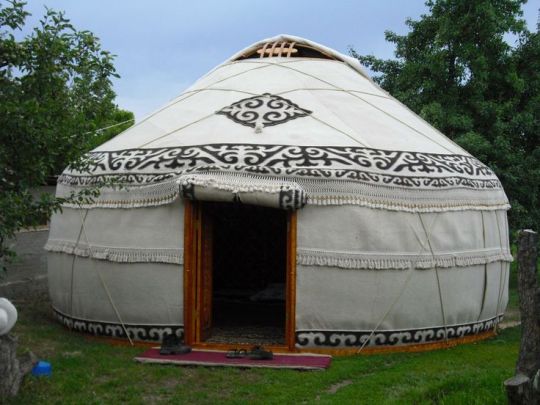
Cuisine
The Kyrgyzstani diet is based on dairy products, meat, rice, and vegetables. Typical dishes include chiuchiuk (horse sausage), dimlama (a stew of meat, onions, potatoes, and vegetables), langman (a dish of meat, noodles, and vegetables), oromo (a steamed pie with minced meat and onions), and qurut (tangy, dried yogurt balls).
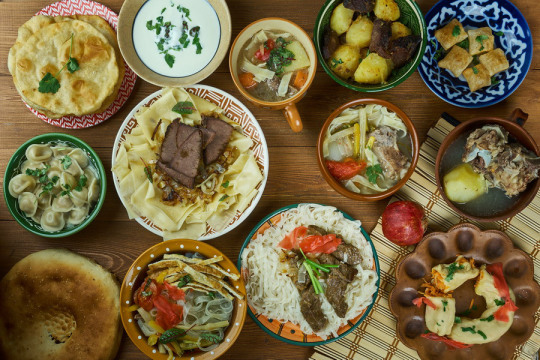
Holidays and festivals
Like other Muslim and Christian countries, Kyrgyzstan celebrates Orthodox Christmas, Eid al-Fitr, and Eid al-Adha. It also commemorates New Year’s Day, International Women’s Day, Persian New Year, and Labor Day.
Specific Kyrgyzstani holidays include Fatherland Defenders’ Day on February 23, Day of National Revolution on April 7, Constitution Day on May 5, Remembrance Day on May 8, Victory Day on May 9, Independence Day on August 31, and Days of History and Commemoration of Ancestors on November 7 and 8.

Independence Day
Other celebrations include the Birds of Prey Festival, the Kyrgyz Kochu Festival, which showcases the art of felt-making, and the National Horse Festival.

Kyrgyz Kochu Festival
Landmarks
There are three UNESCO World Heritage Sites: Silk Roads: the Routes Network of Chang’an-Tianshan Corridor, Sulaiman-Too Sacred Mountain, and Western Tien-Shan.

Sulaiman-Too Sacred Mountain
Other landmarks include the Ala Archa National Park, the Burana Tower, the Holy Trinity Russian Orthodox Cathedral, the Kol-Tor Lake, and the Ruh Ordo Cultural Center.
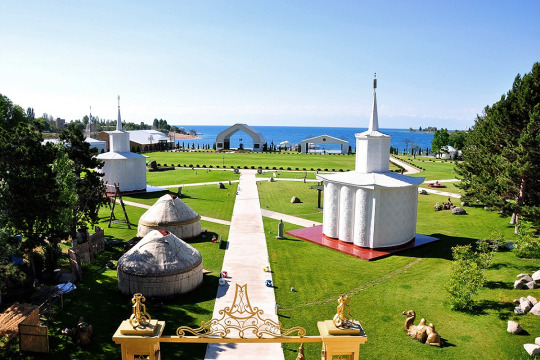
Ruh Ordo Cultural Center
Famous people
Aisuluu Tynybekova - wrestler
Bübüsara Beyshenalieva - dancer
Chinghiz Aitmatov - writer
Kasym Tynystanov - poet
Mirlan Murzayev - soccer player
Salamat Sadikova - singer
Salizhan Sharipov - astronaut
Samal Yeslyamova - actress
Suimonkul Chokmorov - actor and artist
Valentina Shevchenko - mixed martial artist
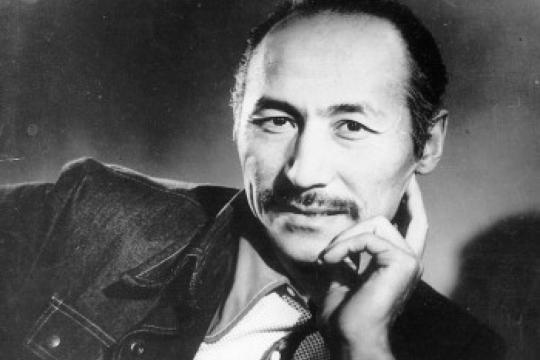
Suimonkul Chokmorov
You can find out more about life in Kyrgyzstan in this article and this video.
4 notes
·
View notes
Text
Sadyr Japarov: Railway from China to Central Asia is a flagship project » English » www.24.kg - KYRGYZSTAN
0 notes